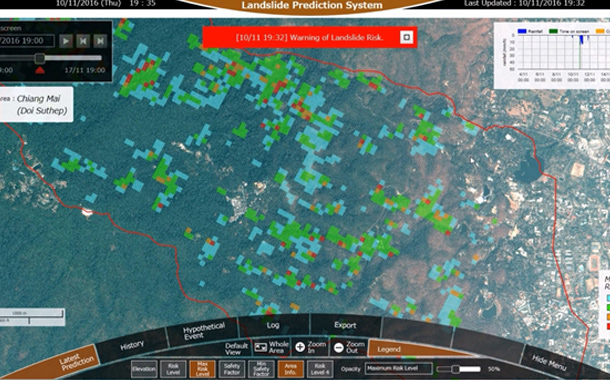Successfully trials Landslide Prediction System in Thailand under the Japan-Thailand cooperation project on disaster prevention ICT
NEC Corporation, in collaboration with Thailand’s National Disaster Warning Center (NDWC), announced the completion of a trial for a system that identifies areas where there is danger of a landslide occurring. The effectiveness of the system was confirmed as the trial was conducted in Chiang Mai Province in Northern Thailand during the period from November 2016 to March 2017.
Landslides caused by heavy rainfall are frequent in Thailand, and they result in personal injury and damage to property as well as affecting transportation by destruction of roads. For those reasons, measures for reducing such damage are urgently needed.
In April 2015, Japan’s Ministry of Internal Affairs and Communications and Thailand’s Ministry of Information and Communication Technology issued a joint statement announcing that the two countries would cooperate in a wide range of areas, including the development of more sophisticated disaster prevention ICT and the use and application of the technologies. As a country that experiences frequent natural disasters, Japan is expected to contribute to disaster prevention in Thailand through provision of its advanced technologies.
This trial supports the disaster prevention cooperation project between Thailand and Japan. NEC conducted this trial in collaboration with the Embassy of Japan in Thailand as part of the “Research and study for the development of a landslide simulator in Thailand” project commissioned by Japan’s Ministry of Internal Affairs and Communications.
NEC joined NDWC in conducting verification experiments with a flooding simulation system in Uttaradit Province in Northern Thailand between November 2015 and March 2016. The trial reported here is a follow-up to that work.
The landslide prediction system is one of the modules of NEC’s “integrated risk management system.” The integrated risk management system consists of a shared platform that has functions such as data integration, visualization, and early warning, and disaster modules specialized for particular disasters such as landslides, flooding, and earthquakes. The disaster modules or functions can be selected individually as required, or several disaster modules can be combined in order to predict multiple disasters simultaneously.
The landslide prediction system performs a simulation based on meteorological data (observed rainfall and forecast rainfall), topographical data (elevation values, land use purposes), and soil data (soil depth, hydraulic conductivity, porosity, cohesion force, internal friction angle, etc.), making it possible to predict the degree of landslide danger.
Further, the system can perform detailed simulations using a 50-m quadrilateral mesh and provide hourly-basis prediction for a period of up to seven days in advance. This allows NDWC to issue warnings to threatened areas before the landslides occur, helping to reduce potential damage. Moreover, even during periods when no disaster is forecast, areas at risk of landslides can be identified by performing simulations using previous rainfall data, which enables hazard maps to be prepared.
“We were able to construct the NEC landslide simulation system in cooperation with various Thai government organizations. The system is optimized for Thailand and is expected to have a role in the operations of the Department of Disaster Prevention and Mitigation and the NDWC,” said RADM Thavorn Charoendee, Executive Expert, National Disaster Warning Center. “With the ongoing cooperation of Japan, the Thai government will continue to expand the simulation area.”
“NEC will continue to contribute to the development of more sophisticated disaster prevention ICT and the use and application of the technology for preventing disasters in Thailand, such as landslides and flooding,” said Minoru Hirata, General Manager, Smart Infrastructure Division, NEC Corporation. “Further, we will harness the experience and knowhow gained through this trial to actively promote the system to other countries in Asia that experience frequent damage from landslides.”


